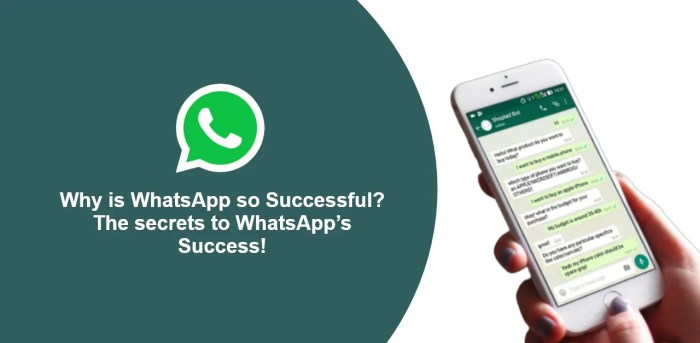Why Do People Use WhatsApp? This question delves into the multifaceted reasons behind the platform’s immense popularity. From personal connections to professional collaborations, WhatsApp has become deeply ingrained in our daily lives. We’ll explore how different demographics, age groups, and cultural contexts shape their usage patterns, uncovering the secrets behind its widespread adoption.
WhatsApp’s features, from simple messaging to video calls, cater to a diverse range of communication needs. We’ll analyze how these features enhance interpersonal relationships and streamline business operations. Further, we’ll examine how WhatsApp has revolutionized communication compared to older methods.
Reasons for WhatsApp Usage

WhatsApp has become an indispensable communication tool, transcending geographical boundaries and social strata. Its ubiquitous nature stems from its ease of use, low cost, and ability to connect people in diverse ways. This exploration delves into the multifaceted reasons behind its popularity, examining motivations across different demographics and social contexts.Understanding the motivations behind WhatsApp usage is crucial for comprehending its impact on personal and professional lives.
The platform’s adaptability allows for a range of interactions, from casual chats with friends to crucial business transactions. This analysis will illuminate the varying reasons for its use, acknowledging how user demographics, age groups, and cultural contexts shape those motivations.
Motivations Behind WhatsApp Usage
WhatsApp’s appeal extends beyond simple messaging, encompassing various aspects of personal and professional life. Individuals utilize it for a multitude of purposes, ranging from maintaining social connections to conducting business transactions.
- Personal Communication: Maintaining close relationships is a primary driver. WhatsApp facilitates instant communication with family, friends, and loved ones, regardless of location. Sharing updates, photos, and videos strengthens bonds and fosters a sense of connection. This is particularly significant for geographically dispersed families and friends. It enables a constant stream of communication, providing an immediate response to inquiries and celebrations.
- Professional Networking: WhatsApp is increasingly used for professional communication. Businesses utilize it for client interaction, project updates, and internal team communication. This often includes sharing documents, scheduling meetings, and collaborating on tasks. In some sectors, WhatsApp’s immediacy is preferred over traditional email for quick responses and urgent matters.
- Social and Community Engagement: WhatsApp groups facilitate interactions within social circles and communities. Sharing information, coordinating events, and organizing activities are common uses. Local groups and interest-based communities leverage WhatsApp for disseminating information and connecting members.
- Entertainment and Information Sharing: WhatsApp is used for sharing news, memes, and other forms of entertainment. Users receive updates on current events, jokes, and other content. Groups dedicated to particular interests or hobbies serve as hubs for sharing and exchanging information.
User Demographics and Motivations
Different user demographics often exhibit distinct motivations for using WhatsApp. Age, cultural background, and professional roles influence how individuals utilize the platform.
- Younger Users: Younger generations are highly active on WhatsApp, primarily for social interactions. They use it for sharing memes, images, and videos, keeping in touch with friends, and organizing social events. Their use is heavily focused on immediate, informal communication.
- Older Users: Older generations might use WhatsApp to maintain contact with family members, particularly those who live far away. They often utilize it for sharing photos and videos, ensuring they stay connected. The use of WhatsApp by older generations demonstrates the platform’s adaptability across age groups.
- Cultural Differences: Cultural norms influence WhatsApp usage. In some cultures, WhatsApp is the primary method of communication for both personal and professional interactions. This contrasts with other cultures where email or other platforms might be more prevalent.
Comparison Across Age Groups and Cultures
The reasons for WhatsApp usage differ across age groups and cultures.
| Reason | Category | Frequency of Use |
|---|---|---|
| Maintaining family connections | Personal | High (especially among older users and geographically dispersed families) |
| Sharing updates and photos | Personal | High (across all age groups) |
| Business communication | Professional | Moderate to High (depending on industry and company size) |
| Coordinating social events | Social/Community | High (among younger users and active community members) |
| Sharing information | Social/Community | Variable (depending on the nature of the group and community) |
WhatsApp’s Features and Functionality
WhatsApp’s success stems largely from its user-friendly interface and a wide array of features designed to meet diverse communication needs. From basic messaging to more complex functionalities like group chats and file sharing, WhatsApp consistently adapts to evolving user expectations. This adaptability, coupled with its intuitive design, has solidified its position as a dominant force in the digital communication landscape.WhatsApp’s core features provide a robust platform for various communication styles.
Whether you need to share quick updates, engage in deep conversations, or collaborate on projects, WhatsApp offers tools that cater to these different needs. Its versatility is a key factor in its widespread adoption and enduring popularity.
Core Messaging Features
WhatsApp’s foundational messaging features are key to its appeal. These features allow for seamless communication, regardless of location or time zone. The simplicity and speed of sending messages are critical to its popularity. The ability to easily exchange messages with friends, family, and colleagues makes it a practical choice for everyday communication.
Group Chat Functionality
WhatsApp’s group chat functionality allows for coordinated communication among numerous participants. Group chats provide a space for organizing events, coordinating projects, or simply connecting with a large network of people. The ability to create and manage these groups, with specific features like @mentions and broadcast lists, is a powerful tool for collaboration and organization. This functionality is highly valued by businesses and individuals alike.
For instance, a team working on a project can easily share updates, documents, and coordinate meetings through a dedicated group chat.
File Sharing and Media Capabilities
WhatsApp’s ability to share various file types and media greatly enhances its functionality. From documents to images and videos, WhatsApp allows for the seamless exchange of information beyond simple text messages. This feature is particularly beneficial for sharing documents, presentations, or even videos during work or school projects. This robust feature is not only useful for personal use but also significantly aids in professional communication.
Voice and Video Calling
The integrated voice and video calling features are indispensable for real-time interaction. WhatsApp’s seamless video calls enable face-to-face communication, fostering stronger connections. This feature is incredibly valuable in scenarios where immediate and clear communication is crucial, like family check-ins, virtual meetings, or client consultations.
WhatsApp Business
WhatsApp Business offers tailored features for businesses, enhancing communication and customer service. Dedicated features like automated replies and business profiles allow businesses to streamline their communication and engagement with customers. This makes it a convenient platform for businesses to manage interactions and provide support to clients. For instance, a small business owner can use WhatsApp Business to manage orders, answer customer inquiries, and provide updates in a structured manner.
Comparison with Other Messaging Platforms
While other messaging platforms like Telegram, Signal, and Facebook Messenger offer similar functionalities, WhatsApp stands out for its widespread adoption and user base. This broad reach and established user ecosystem often make it a convenient choice for maintaining contact with a large number of individuals. Its robust file sharing capabilities, coupled with its intuitive interface, contribute to its appeal over other platforms.
People use WhatsApp for quick communication, staying connected with friends and family, and sharing updates. It’s a convenient platform for daily interactions, but sometimes I find myself wondering if the constant notifications are worth it. For example, did you hear about Azealia Banks teaming up with Busta Rhymes to remix Beyoncé’s “Partition”? This awesome collaboration just goes to show how creative people can be, and perhaps, that’s why we also love staying connected through WhatsApp; it allows us to quickly share these exciting finds with our friends.
Overall, WhatsApp’s convenience is hard to beat.
Key Features and User Benefits
| Feature | User Benefit |
|---|---|
| Messaging | Fast, reliable communication |
| Group Chats | Organized communication with multiple participants |
| File Sharing | Easy sharing of documents, images, and videos |
| Voice/Video Calls | Real-time interaction and connection |
| WhatsApp Business | Enhanced communication and customer service for businesses |
WhatsApp’s Impact on Communication
WhatsApp has revolutionized communication, transforming the way people connect, collaborate, and build communities. Its accessibility and ubiquitous use have profoundly altered the landscape of interpersonal interactions, business practices, and social engagement. This impact extends from personal relationships to global business networks and local communities.
Alteration of the Communication Landscape
WhatsApp’s widespread adoption has led to a shift in how people communicate. Instant messaging, voice calls, and video calls have become the norm, replacing or supplementing traditional methods like phone calls and text messaging. This accessibility has fostered greater connectivity, particularly across geographical distances. The ease of use and low cost associated with WhatsApp have made it a preferred method for individuals and businesses alike.
Furthermore, its integration of various features, like group chats and file sharing, facilitates collective communication and information exchange on a massive scale.
Impact on Interpersonal Relationships
WhatsApp’s impact on interpersonal relationships is multifaceted. It has facilitated closer connections by enabling constant communication. However, it has also introduced potential challenges. Maintaining a healthy balance between online and offline interaction is crucial. Over-reliance on digital communication can sometimes hinder the development of face-to-face relationships.
Effective communication strategies must address this challenge by recognizing the benefits and limitations of digital communication in personal relationships. Maintaining genuine connections while leveraging the benefits of instant communication is paramount.
Effects on Business Communication and Collaboration
WhatsApp’s role in business communication is undeniable. It has become a vital tool for businesses of all sizes, fostering seamless communication among teams and clients. WhatsApp enables real-time updates, quick responses, and streamlined collaboration. This efficiency translates to increased productivity and cost savings. Furthermore, its features like group chats and file sharing facilitate team projects and client communication, enabling businesses to operate more efficiently and responsively.
Role in Community Building and Social Interaction
WhatsApp groups have become central hubs for community building. They allow individuals to connect with others who share common interests, hobbies, or geographical locations. This fosters a sense of belonging and provides a platform for social interaction and engagement. From local neighborhood groups to global support networks, WhatsApp enables the creation and maintenance of diverse communities. However, responsible moderation and clear guidelines are necessary to ensure a positive and productive online environment.
Comparison of WhatsApp’s Impact with Older Communication Forms
| Communication Form | Key Characteristics | WhatsApp Impact Comparison |
|---|---|---|
| Letters/Postal Mail | Slow delivery, physical medium | Instantaneous delivery, digital medium |
| Phone Calls | Real-time audio communication, limited information exchange | Real-time audio/video communication, greater flexibility in information exchange |
| SMS Messaging | Limited text capacity, one-on-one communication | Extensive text capacity, group communication, multimedia sharing |
| Delayed delivery, formal communication | Instantaneous delivery, informal to formal communication |
This table highlights the significant shifts in communication brought about by WhatsApp. It has drastically improved speed, efficiency, and capacity compared to traditional methods. The ability to exchange various forms of media instantly is a key differentiating factor. This accessibility has profound effects on both personal and professional communication.
WhatsApp’s Role in Daily Life
WhatsApp has seamlessly integrated itself into the fabric of modern life, becoming more than just a communication tool. It’s a central hub for connecting with friends, family, and colleagues, often dictating how we manage daily tasks and errands. This deep integration has profound implications for how we interact, work, and generally navigate our routines.WhatsApp’s influence extends beyond simple messaging, profoundly impacting productivity and efficiency.
From coordinating schedules to managing to-do lists and even handling errands, WhatsApp’s versatility has made it an indispensable part of the daily routines of millions.
Daily Communication Patterns, Why Do People Use WhatsApp
WhatsApp has reshaped how we communicate, moving beyond simple text messages. Video calls and group chats have become common, allowing for real-time interaction with a multitude of contacts. This shift from impersonal text exchanges to more personal interactions has led to a more nuanced understanding of relationships.
People use WhatsApp for quick communication, staying connected, and sharing updates. But, sometimes, that need for instant messaging can extend to strategic planning, like when coordinating a Bloons TD 6 Strategy Bloons TD 6 Strategy. Knowing where to place your towers and how to counter the oncoming hordes of Bloons requires a similar level of quick communication and coordination.
Ultimately, WhatsApp, in its simplicity, serves as a vital tool for staying connected, whether it’s for casual chat or strategic gaming.
Task Management and Errand Coordination
WhatsApp’s role in managing tasks and coordinating errands is significant. Group chats are particularly useful for organizing events, coordinating schedules, and sharing information among participants. This collaborative aspect of WhatsApp streamlines processes and ensures everyone is on the same page. Examples range from scheduling a team meeting to organizing a house party, all facilitated by WhatsApp group chats.
Impact on Productivity and Efficiency
WhatsApp’s integration into daily life can have a notable effect on productivity. By streamlining communication, it allows for faster responses and quicker decision-making. This can significantly improve efficiency in various aspects of life, from work projects to personal commitments. For example, sharing documents, images, and links within a group chat allows for instant collaboration and avoids the delays associated with traditional email exchanges.
Examples of WhatsApp-Facilitated Tasks
WhatsApp facilitates a wide array of tasks, going beyond simple communication. Its use extends to everything from ordering groceries and booking appointments to sharing important documents and managing to-do lists. This versatility makes it an integral part of many individuals’ daily lives.
| Task Category | Specific Tasks/Activities |
|---|---|
| Scheduling | Coordinating meetings, arranging appointments, sharing calendars |
| Shopping | Ordering groceries, coordinating pickups, sharing shopping lists |
| Errands | Coordinating drop-offs, pickups, or delivery of items |
| Information Sharing | Sharing important documents, updates, or reminders |
| Collaboration | Working on projects, sharing ideas, feedback, and progress reports |
| Social Events | Planning parties, coordinating outings, sharing event details |
WhatsApp’s Evolution and Future
WhatsApp, initially conceived as a simple way to message friends, has evolved into a ubiquitous communication platform, deeply interwoven with our daily lives. Its journey reflects the ever-changing landscape of mobile technology and user expectations, highlighting both its adaptability and the challenges inherent in maintaining relevance in a rapidly evolving digital world.
A Timeline of WhatsApp’s Evolution
WhatsApp’s growth isn’t a linear progression; it’s a story of adapting to new needs and opportunities. This timeline showcases key milestones that shaped the platform we know today.
- 2009-2011: The Early Days of Instant Messaging
-WhatsApp’s early years were focused on establishing a robust instant messaging system. The platform’s primary function was the exchange of text messages between contacts, with limited functionality beyond basic communication. The initial focus was on creating a user-friendly platform for mobile communication, enabling seamless interaction between friends and family. - 2012-2014: Expanding Functionality and User Base
– As WhatsApp gained popularity, the platform expanded its features to include multimedia sharing, such as images and videos. This diversification broadened its appeal and facilitated richer communication experiences, moving beyond text-based conversations. The platform also began to see significant growth in its user base, indicating its increasing adoption within social circles. - 2015-2018: Integrating with Business and Beyond
– WhatsApp began to integrate with business communication. The introduction of business accounts, and later, more sophisticated tools like WhatsApp Business API, enabled businesses to communicate effectively with customers. This shift marked a significant transition from a primarily personal platform to a more versatile communication tool. The emphasis was on creating a seamless experience for both personal and business interactions. - 2019-Present: Enhancing Security and Privacy
– Concerns about privacy and security have become increasingly important. WhatsApp has focused on strengthening its security protocols and improving user privacy controls. This is a crucial aspect to ensure user trust and maintain a reliable communication channel. The platform is actively seeking to address security vulnerabilities and proactively implement privacy safeguards.
Adapting to Changing User Needs
WhatsApp’s ability to adapt to evolving user needs is a crucial factor in its ongoing success. The platform continuously adjusts its features and services to keep pace with user demands and technological advancements.
- Voice and Video Calls
-The introduction of voice and video calling significantly enhanced the platform’s capabilities. Users now have a wide range of options for interacting with contacts, including more intimate and engaging conversations. - Status Updates
– The implementation of status updates allowed users to share more personal information and experiences with contacts. This provided a means of conveying daily activities and emotional states, enhancing the social aspect of the platform. - Evolving Business Features
– WhatsApp has continued to develop business-oriented features to cater to the needs of businesses and entrepreneurs. This has included enhancements for customer service, marketing, and sales interactions.
Potential Future Developments
WhatsApp’s future trajectory hinges on its ability to innovate and cater to the evolving needs of its users. Several potential developments could shape the platform’s future.
- Enhanced End-to-End Encryption
– WhatsApp will likely continue to refine its end-to-end encryption capabilities to enhance security and privacy. This ensures that only the intended recipient can access messages. - Integration with Emerging Technologies
– The potential for integration with other emerging technologies, such as AI-powered chatbots or augmented reality features, presents exciting possibilities for WhatsApp. - Improved Business Tools
– More sophisticated tools to manage customer interactions, analytics, and marketing campaigns could further enhance WhatsApp’s appeal to businesses.
Challenges and Opportunities
WhatsApp faces challenges in maintaining its user base and navigating evolving regulatory landscapes. Simultaneously, opportunities exist for growth and innovation.
- Competition from Other Platforms
– WhatsApp faces increasing competition from other messaging platforms. The need to maintain its competitive edge through innovation and user-centric design is crucial. - Maintaining User Trust
– Maintaining user trust and privacy is paramount. Robust security measures and transparent communication are essential to build and maintain user confidence. - Expanding Global Reach
– Further expansion into global markets and addressing local communication needs is an important opportunity for WhatsApp.
WhatsApp and Privacy Concerns
WhatsApp’s ubiquitous nature has made it a cornerstone of modern communication, but its widespread use raises legitimate privacy concerns. While WhatsApp strives to maintain user security, the platform’s complex architecture and reliance on third-party services introduce vulnerabilities that require careful consideration. Understanding these issues is crucial for responsible usage and informed decision-making.
People use WhatsApp for quick communication, sharing files, and staying connected with friends and family. It’s a simple, reliable platform for daily interactions. However, if you’re looking to improve your communication skills and learn a more sophisticated accent, consider Learn a British Accent to expand your linguistic horizons. Ultimately, WhatsApp’s popularity is driven by its ease of use and ability to connect people globally.
Privacy Implications of WhatsApp Usage
WhatsApp’s data collection practices, while intended to improve functionality, have sparked privacy debates. The platform gathers user data to personalize services, track usage patterns, and facilitate features like group chats and business messaging. This data collection includes metadata like timestamps, location information (in some cases), and content of messages. The potential for misuse or unauthorized access of this data is a significant concern.
Furthermore, the evolving nature of technology and potential future vulnerabilities should be factored into privacy considerations.
Security Measures Employed by WhatsApp
WhatsApp employs several security measures to protect user data. End-to-end encryption is a key component, ensuring that only the sender and recipient can access the content of messages. This encryption protects against eavesdropping by third parties, including WhatsApp itself. Moreover, WhatsApp utilizes robust authentication protocols to verify user identities and prevent unauthorized access. These security measures, though substantial, are not foolproof, and vulnerabilities may arise in the future.
User’s Role in Safeguarding WhatsApp Privacy
Users play a crucial role in maintaining their privacy on WhatsApp. Regularly reviewing and updating privacy settings is essential to control the information shared. Being cautious about the types of content shared, particularly sensitive information, is vital. Furthermore, users should exercise caution when interacting with unknown individuals or groups, as this can expose them to potential security risks.
Keeping WhatsApp updated with the latest security patches is another crucial step.
Comparison of WhatsApp’s Privacy Policies with Other Messaging Platforms
Comparing WhatsApp’s privacy policies with those of other messaging platforms reveals variations in approach. Some platforms prioritize user data control and transparency more than others. The extent of data collection and retention policies, as well as the level of user control over data sharing, can differ significantly between platforms. A comprehensive comparison requires careful analysis of each platform’s terms of service and privacy policies.
Potential Privacy Concerns and WhatsApp’s Responses
| Potential Privacy Concerns | WhatsApp’s Responses |
|---|---|
| Data breaches and unauthorized access | Robust security measures, including end-to-end encryption and regular security audits. |
| Metadata collection and potential misuse | Transparency regarding data collection practices and user control over data sharing. |
| Sharing of user data with third parties | Clear policies outlining data sharing practices and user consent mechanisms. |
| Lack of user control over data retention | Providing options for deleting accounts and data. |
The table above highlights key concerns and WhatsApp’s efforts to address them. However, the ongoing evolution of technology necessitates continuous vigilance and adaptation in addressing emerging privacy challenges.
WhatsApp and Business Use

WhatsApp has evolved from a personal communication tool to a powerful platform for businesses of all sizes. Its ubiquity and user-friendly interface make it an attractive channel for customer service, marketing, and internal communication. Businesses are increasingly leveraging WhatsApp’s capabilities to streamline processes, enhance customer engagement, and boost overall efficiency.Businesses recognize the potential of WhatsApp to foster deeper connections with their customer base.
Direct messaging allows for personalized interactions, fostering loyalty and repeat business. The platform’s accessibility and real-time nature make it an ideal tool for immediate responses and problem resolution.
Customer Service and Support
WhatsApp provides a readily accessible channel for customer support. Businesses can offer prompt responses to inquiries, resolve issues quickly, and build stronger customer relationships. The ability to directly address concerns in a conversational manner fosters a sense of personalized care. This immediate interaction often leads to increased customer satisfaction and loyalty. Many businesses utilize WhatsApp for handling routine inquiries, scheduling appointments, and providing technical assistance.
WhatsApp for Marketing and Promotions
Businesses use WhatsApp to deliver targeted marketing messages and promotions directly to their customer base. This targeted approach allows for a personalized experience that resonates with individual customers. Businesses can create automated messages for welcome sequences, promotional offers, and order confirmations, all while maintaining a sense of human connection. Examples include sending personalized recommendations, announcing exclusive deals, and managing loyalty programs.
Internal Communication within Organizations
WhatsApp facilitates efficient internal communication within organizations. Teams can share updates, collaborate on projects, and coordinate efforts in real-time. The platform’s ease of use allows for quick dissemination of information, reducing response times and fostering a sense of teamwork. File sharing and group chats are integral to this process. This enhanced communication often leads to increased productivity and a smoother workflow.
Transforming Business Processes
WhatsApp has revolutionized business processes across diverse industries. For example, in the e-commerce sector, it allows for seamless order tracking and updates, while in the hospitality industry, it enables reservations and confirmations. This immediacy streamlines workflows and reduces administrative burdens. Real-time communication with customers fosters responsiveness, which is crucial in today’s fast-paced market. This adaptability allows businesses to quickly adjust to changing market demands.
Effective WhatsApp Customer Engagement
Implementing a successful WhatsApp customer engagement strategy requires careful planning and execution. Businesses must establish clear protocols for response times, define roles and responsibilities for handling customer inquiries, and ensure that customer data is managed securely. Furthermore, integrating WhatsApp with other CRM systems enhances the efficiency and accuracy of customer interactions. Businesses should prioritize building trust and fostering a positive customer experience.
Key steps include training staff, providing clear guidelines, and monitoring performance metrics to continuously improve customer engagement.
Concluding Remarks: Why Do People Use WhatsApp
In conclusion, WhatsApp’s ubiquitous presence stems from its ability to connect people across personal and professional spheres. Its evolving features and functionality have transformed how we communicate, collaborate, and stay connected. While privacy concerns remain a factor, WhatsApp’s role in daily life is undeniable. Its adaptability and integration into various aspects of our lives have cemented its position as a cornerstone of modern communication.




